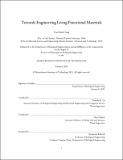Towards engineering living functional materials
Author(s)
Tang, Tzu-Chieh,Ph. D.Massachusetts Institute of Technology.
Download1252627180-MIT.pdf (19.61Mb)
Other Contributors
Massachusetts Institute of Technology. Department of Biological Engineering.
Advisor
Timothy K. Lu and Neri Oxman.
Terms of use
Metadata
Show full item recordAbstract
Synthetic biology has become one of the most rapidly evolving research fields, with impacts on all aspects of our daily life. Through applying engineering principles to programming biological systems, synthetic biology provides advanced techniques to program organisms to perform desired tasks, similar to machines created by humans. Today, it has enabled the development of alternative meat substitutes, biosensors for water contamination, and living fertilizers that promote plant growth. The grand challenge to bridge the concept-to-product gap is twofold: scalability and safe deployment. First, most model microorganisms cannot produce a macroscale matrix to sustain themselves as standalone devices. The field of engineered living materials (ELMs) aims to recapitulate the remarkable properties of natural biology to create novel, growable, multifunctional materials using genetically engineered organisms. Nevertheless, most relevant pioneering work was created using nano- to microscale biofilm, which has rather small yields and usually requires costly modification. Second, releasing genetically modified microorganisms (GMMs) into the field for food, water, or agricultural applications is often considered risky due to the uncertainty of wild-type organisms acquiring undesirable traits, such as antibiotic resistance, from the GMMs. A significant effort in addressing these unmet needs is called for. This Thesis starts with an introduction of genetic circuits and an in-depth review of the current trends in materials synthetic biology, which includes two major categories of ELMs: self-organizing functional materials and hybrid living materials. The following chapters describe the technologies developed to achieve high scalability and safe deployment of ELMs in these two categories and living devices suitable for real-world applications. Finally, a detailed outlook summarizes the challenges and prospects for materials synthetic biology and engineering living functional materials.
Description
Thesis: Ph. D., Massachusetts Institute of Technology, Department of Biological Engineering, February, 2021 Cataloged from the official PDF version of thesis. Includes bibliographical references (pages 206-221).
Date issued
2021Department
Massachusetts Institute of Technology. Department of Biological EngineeringPublisher
Massachusetts Institute of Technology
Keywords
Biological Engineering.